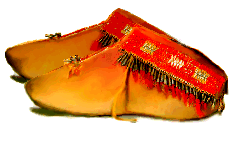Shoes, Stockings and Buckles
|
THE ART AND MYSTERY OF A CORDWAINER; OR, AN ESSAY ON THE PRINCIPLES AND PRACTICE OF BOOT AND SHOEMAKING. Written in 1813
|
|
Men's Footwear Bruce McNeal's Fugawee shoes along with fancy buckles from G..G. Godwin.
Man's Shoe circa 1775 (Nat'l Gallery of Art) |
Women's Footwear A pair of extant lady's silk slippers circa 1735. The Northampton Borough Council web site offers pictures of extant shoes from 18th century England, including children's' women's and men's shoes.
|
|
The Use of Moccasins Moccasins appears to have been adopted by the 18th century backwoodsman, from the frontier sections, and was not common shoe wear for the more settled regions of the colonies, if you were white.
|
Stockings These could be made out woven fabric or woven from yarn and were usually made out of silk, wool, linen, or a combination of these yarns. They could be shaped after weaving or sometimes they were knit to shape on knitting needles. Stockings were very fitted. Since modern knits have "stretch" to them, and 18th century yarns did not, stockings had to made to fit the wearer's calves and thighs. To keep them secure, cloth tapes were used just below or above the knee. A military man would use leather decorative straps and buckles to secure his stockings. Kannicks Korner offers a pattern to construct stockings out of knitted fabric Mara Riley offers instructions to knit stockings. |
|
Buckles Karen Augusta is offering a pair of gentlemen's silver and paste buckles More paste-stone buckles, some in their original cases. G.G.Godwin offers a variety of recreated shoe buckles |
Rebecca Manthey has online instructions for constructing your own authentic 18th century stockings. |
 Another method of fastening shoes involved using ribbon or tapes
to secure latchets which are folded over. Straight-lasted
shoes were used up until about the
1840's
or so, when the industrial revolution allowed both lasts
(which
wore out quickly)
and shoe manufacturing to become more automated.
Another method of fastening shoes involved using ribbon or tapes
to secure latchets which are folded over. Straight-lasted
shoes were used up until about the
1840's
or so, when the industrial revolution allowed both lasts
(which
wore out quickly)
and shoe manufacturing to become more automated.
